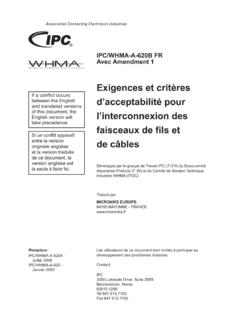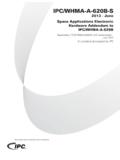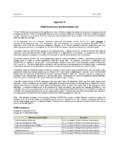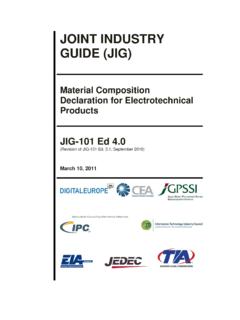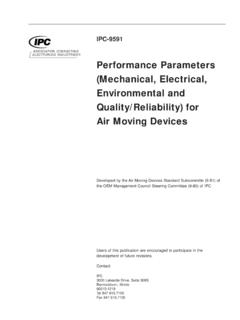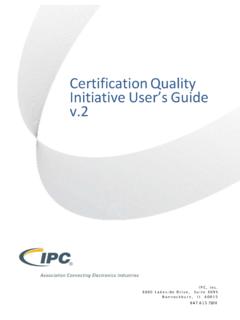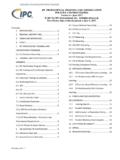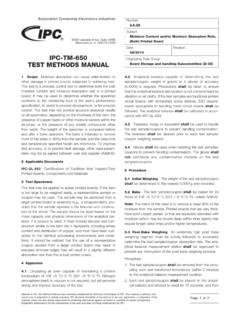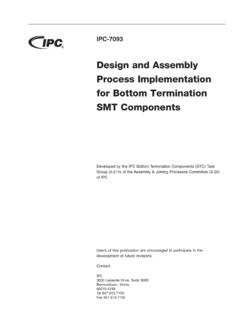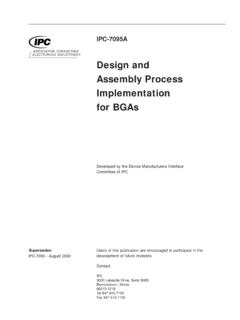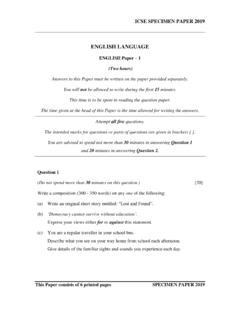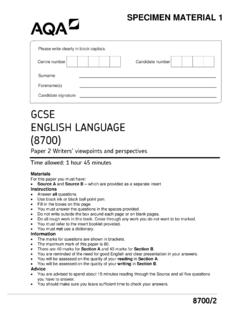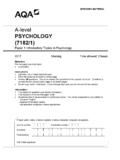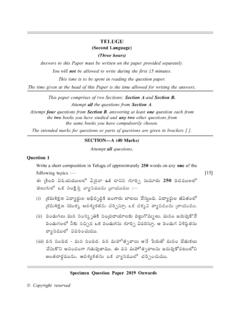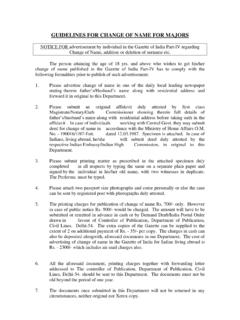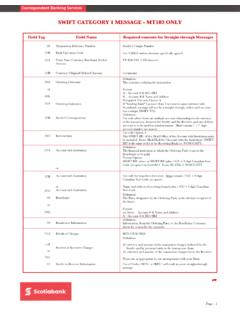Transcription of ELECTRONICS INDUSTRIES Solderability Tests for Printed …
1 IPC J-STD-003 BSolderabilityTests forPrinted BoardsDeveloped by the Printed Wiring board Solderability Specification TaskGroup (5-23a) of the Assembly & Joining Processes Committee (5-20)of IPCU sers of this publication are encouraged to participate in thedevelopment of future :IPC3000 Lakeside Drive, Suite 309 SBannockburn, IL 60015-1249 Phone ( 847) 615-7100 Fax (847) 615-7105 Supersedes:J-STD-003A - February 2003J-STD-003 - April 1992 IPC-S-804A - January 1987 IPC-S-803 IPC-S-801 ASSOCIATION CONNECTINGELECTRONICS INDUSTRIES Table of .. or Should .. Hierarchy .. Classes .. Classification .. Acceptance Criteria Tests .. Measurement Criteria Tests .. (s) Methodologies Under CommitteeReview .. Method Selection .. Specimen Requirements .. Durability .. 32 APPLICABLE .. and Definitions .. Maintenance .. Removal.
2 Equipment .. Pot/Bath .. Inspection Equipment .. Equipment .. Equipment .. for Testing .. Specimen Preparation andConditioning for Test .. Conditioning .. Bath Requirements .. Temperatures .. Contamination Control .. 54 TEST Procedure Limitations .. of Flux .. with Established Accept/Reject Criteria .. A Edge Dip Test Tin/Lead Solder .. Pot/Bath .. Device .. Specimen .. Evaluation Accept/Reject Criteria .. B Rotary Dip Test Tin/Lead Solder .. Specimen .. Evaluation Accept/Reject Criteria .. Hole Evaluation .. C Solder Float Test Tin/Lead Solder .. Pot .. Specimen Handling Tool .. Specimen .. Evaluation Accept/Reject Criteria .. Hole Evaluation .. D Wave Solder Test Tin/Lead Solder .. Specimen .. Evaluation Accept/Reject Criteria .. Hole Evaluation.
3 12 March 2007 IPC E Surface Mount ProcessSimulation Test Tin/Lead Solder .. Application Tool .. Specimen .. Equipment .. Evaluation Accept/Reject Criteria .. A1 Edge Dip Test Lead-Free Solder .. Pot/Bath .. Device .. Specimen .. Evaluation Accept/Reject Criteria .. B1 Rotary Dip Test Lead-Free Solder .. Specimen .. Evaluation Accept/Reject Criteria .. Hole Evaluation .. C1 Solder Float Test Lead-Free Solder .. Pot .. Specimen Handling Tool .. Specimen .. Evaluation Accept/Reject Criteria .. Hole Evaluation .. D1 Wave Solder Test Lead-Free Solder .. Specimen .. Evaluation Accept/Reject Criteria .. Hole Evaluation .. E1 Surface Mount ProcessSimulation Test Lead-Free Solder .. Stencil/Screen .. Paste Application Tool .. Specimen .. Equipment .. Magnification.
4 Surface Evaluation Accept/Reject Criteria .. with Force Measurement Criteria .. F Wetting Balance Test:Tin/Lead Solder .. Device .. Specimen .. Criteria .. Repeatability andReproducibility (GR&R) Protocol .. F1 Wetting Balance Test:Lead-Free Solder .. Device .. Specimen .. Criteria .. Repeatability andReproducibility (GR&R) Protocol .. 215 EVALUATION Aids Surface .. Aids For Class 3 Plated-Through Holes .. 23 IPC J-STD-003 BMarch for Buoyancy .. Note .. of Nonactivated Flux .. Contact .. 23 APPENDIX ACalculation of MaximumTheoretical Force for aRectangular 24 APPENDIX BCalculation of Area Underthe Wetting 25 APPENDIX CInformative 26 APPENDIX DTest Protocol for WettingBalance Gauge Repeatabilityand Reproducibility (GR&R)Using Copper Foil 27 APPENDIX EJ-STD-002/J-STD-003 ActivatedSolderability Test Flux RationaleCommittee 28 FiguresFigure 3-1 Contact Angle.
5 3 Figure 3-2 Example Reticle .. 5 Figure 4-1 Edge Dip Solderability Test .. 7 Figure 4-2 Suggested Test Specimen for Plated-Through Holes .. 8 Figure 4-3 Suggested Test Specimen for SurfaceMount Features .. 8 Figure 4-4 Rotary Dip Test .. 9 Figure 4-5 Effectiveness of Solder Wetting ofPlated-Through Holes - Class 3 .. 10 Figure 4-6 Examples of Solder Wetting of Plated-Through Holes - Class 3 .. 10 Figure 4-7 Wetting Balance Apparatus .. 18 Figure 4-8 Suggested Wetting Balance TestSpecimens and Soldering Immersion .. 18 Figure 4-9 Wetting Balance Test Soldering Immersion .. 19 Figure 4-10 Set A Wetting Curve .. 20 Figure 4-11 Set B Wetting Curve .. 20 Figure 5-1 Aid to Evaluation .. 22 TablesTable 1-1 Test Method Selection .. 2 Table 1-2 Conditioning and Test Requirements .. 3 Table 3-1 Flux Composition .. 4 Table 3-2 Maximum Limits of Solder Bath Contaminant.
6 5 Table 4-1 Stencil Thickness Requirements .. 12 Table 4-2 Reflow Parameter Requirements .. 12 Table 4-3 Stencil Thickness Requirements .. 17 Table 4-4 Lead-Free Reflow Parameter Requirements .. 17 Table 4-5 Wetting Balance Parameter andSuggested Criteria .. 19 Table 4-6 Wetting Balance Parameter andSuggested Criteria .. 21 March 2007 IPC J-STD-003 BviiSolderability Tests for Printed Boards1 ScopeThis standard prescribes test methods, defectdefinitions and illustrations for assessing the solderabilityof Printed board surface conductors, attachment lands, andplated-through holes. This standard is intended for use byboth vendor and PurposeThe Solderability determination is made toverify that the Printed board fabrication processes and sub-sequent storage have had no adverse effect on the solder-ability of those portions of the Printed board intended to besoldered.
7 This is determined by evaluation of the solder-ability test specimen portion of a board or representativetest specimen which has been processed as part of thepanel of boards and subsequently removed for testing perthe method ObjectiveThe objective of the Solderability testmethods described in this standard is to determine the abil-ity of Printed board surface conductors, attachment lands,and plated-through holes to wet easily with solder and towithstand the rigors of the Printed board assembly Shall or ShouldThe word shall is used in thetext of this document wherever there is a requirement formaterials, preparation, process control or acceptance of asoldered connection or a test method. The word should reflects recommendations and is used to reflect generalindustry practices and procedures for guidance Document HierarchyIn the event of conflict, thefollowing descending order of precedence applies:1.
8 Procurement as agreed between user and Master drawing or master assembly drawing reflectingthe user s detailed When invoked by the customer or per contractual agree-ment, this document, Other documents to extent specified by the Performance ClassesThree general classes havebeen established to reflect progressive increases in sophis-tication, functional performance requirements and testing/inspection frequency. It should be recognized that theremay be an overlap of equipment categories in differentclasses. The user has the responsibility to specify in thecontract or purchase order the performance class requiredfor each product andshallindicate any exceptions to spe-cific parameters, where 1 General Electronic ProductsIncludes consumer products, some computer and computerperipherals suitable for applications where cosmetic imper-fections are not important and the major requirement isfunction of the completed Printed 2 Dedicated Service Electronic ProductsIncludes communications equipment, sophisticated busi-ness machines, instruments where high performance andextended life is required and for which uninterrupted ser-vice is desired but not critical.
9 Certain cosmetic imperfec-tions are 3 High Performance Electronic ProductsIncludes the equipment and products where continued per-formance or performance on demand is critical. Equipmentdowntime cannot be tolerated and must function whenrequired such as in life support items or flight control sys-tems. Printed boards in this class are suitable for applica-tions where high levels of assurance are required and ser-vice is Method ClassificationThis standard describes testmethods by which both the surface conductors (and attach-ment lands) and plated-through holes may be evaluated forsolderability. Test A, Test B, Test C, Test D and Test E fortin/lead solder processes and Test A1, Test B1, Test C1,Test D1 and Test E1 for lead-free solder processes, unlessotherwise agreed upon between vendor and user. Test Aand Test C for tin/lead solder processes, Test A1 and TestC1 for lead-free solder processes are to be used as a defaultsolderability are made for this determination to be performedat the time of manufacture, at the receipt of the boards bythe user, or just prior to assembly and soldering.
10 User andvendorshallagree to the appropriate method to be usedand their dwell times are defined in some of the methodscalled out in this standard. Variations in board heat capac-ity may necessitate the use of longer solder dwell times(see ). Any change in solder dwellshallbe agreed uponby user and Visual Acceptance Criteria TestsTin Lead Solder AlloyTest A Edge Dip TestFor surface conductors andattachment lands only (see )Test B Rotary Dip TestFor plated-through holes, sur-face conductors and attachment lands, solder source side(see )March 2007 IPC J-STD-003B1
